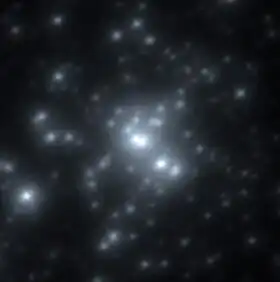R136a3
R136a3 is a Wolf–Rayet star in R136, a massive star cluster located in Dorado. It is located near R136a1, the most massive and luminous star known. R136a3 is itself one of the most massive and most luminous stars known at about 179 times more massive and 5 million times more luminous than the Sun.
 R136a3 is the bright star at lower right of the center. | |
| Observation data Epoch J2000 Equinox J2000.0 | |
|---|---|
| Constellation | Dorado |
| Right ascension | 05h 38m 42.33s[1] |
| Declination | −69° 06′ 03.27″[1] |
| Apparent magnitude (V) | 12.97[1] |
| Characteristics | |
| Evolutionary stage | Wolf–Rayet star |
| Spectral type | WN5h[2] |
| Astrometry | |
| Distance | 163,000 ly (49,970[3] pc) |
| Absolute magnitude (MV) | −7.52[4] |
| Details[5][6] | |
| Mass | 155+25 −18 M☉ |
| Radius | 25.5+4.1 −3.5 R☉ |
| Luminosity | 3,631,000 L☉ |
| Temperature | 50,000+2,500 −8,000 K |
| Age | 1.28+0.17 −0.21 Myr |
| Other designations | |
| Database references | |
| SIMBAD | data |
The formal name of the star is RMC 136a3, standing for Radcliffe observatory, Magellanic Clouds, 136a3. The RMC survey identified luminous objects in the Large Magellanic Cloud and one of the brightest was RMC 136. This is now commonly shortened to R136, which is now known to be an extremely young dense open cluster at the core of the NGC 2070 cluster in the Tarantula Nebula. R136 was eventually resolved and the brightest "star" at the centre was termed R136a. This was further resolved into multiple components, one of which is R136a3.
Although R136a3 has a Wolf-Rayet spectral type dominated by intense emission lines of helium and nitrogen, usually indicating a highly evolved star that has lost its outer layers, R136a3 is actually an extremely young star. The spectrum also includes hydrogen lines and analysis shows the star is still 40% hydrogen at the surface. The helium and nitrogen in the atmosphere of such a young star are caused by strong convection due to the massive core and intense CNO cycle fusion, enhanced further by rotational mixing. The emission lines in the spectrum indicate strong mass loss caused by the fusion products at the surface and the enormous luminosity.[2][7]
References
- Doran, E. I.; Crowther, P. A.; De Koter, A.; Evans, C. J.; McEvoy, C.; et al. (October 2013). "The VLT-FLAMES Tarantula Survey. XI. A census of the hot luminous stars and their feedback in 30 Doradus". Astronomy & Astrophysics. 558. A134. arXiv:1308.3412. Bibcode:2013A&A...558A.134D. doi:10.1051/0004-6361/201321824. S2CID 118510909.
- Crowther, Paul A.; Caballero-Nieves, S. M.; Bostroem, K. A.; Maíz Apellániz, J.; Schneider, F. R. N.; et al. (May 2016). "The R136 star cluster dissected with Hubble Space Telescope/STIS. I. Far-ultraviolet spectroscopic census and the origin of He II λ1640 in young star clusters". Monthly Notices of the Royal Astronomical Society. 458 (1): 624–659. arXiv:1603.04994. Bibcode:2016MNRAS.458..624C. doi:10.1093/mnras/stw273.
- Pietrzyński, G.; Graczyk, D.; Gieren, W.; Thompson, I. B.; Pilecki, B.; et al. (March 2013). "An eclipsing-binary distance to the Large Magellanic Cloud accurate to two per cent". Nature. 495 (7439): 76–79. arXiv:1303.2063. Bibcode:2013Natur.495...76P. doi:10.1038/nature11878. PMID 23467166. S2CID 4417699.
- Bestenlehner, Joachim M.; Crowther, Paul A.; Caballero-Nieves, Saida M.; Schneider, Fabian R. N.; Simón-Díaz, Sergio; Brands, Sarah A.; De Koter, Alex; Gräfener, Götz; Herrero, Artemio; Langer, Norbert; Lennon, Daniel J.; Maíz Apellániz, Jesus; Puls, Joachim; Vink, Jorick S. (2020). "The R136 star cluster dissected with Hubble Space Telescope/STIS. II. Physical properties of the most massive stars in R136". Monthly Notices of the Royal Astronomical Society. 499 (2): 1918. arXiv:2009.05136. Bibcode:2020MNRAS.499.1918B. doi:10.1093/mnras/staa2801.
- Brands, S.; de Koter, A.; Bestenlehner, J.; Crowther, P.; Sundqvist, J.; Puls, J.; Caballero-Nieves, S.; Abdul-Masih, M.; Driessen, F.; Garcia, M.; Geen, S.; Gräfener, G.; Hawcroft, C.; Kaper, L.; Keszthelyi, Z.; Langer, N.; Sana, H.; Schneider, Fabian R. N.; Shenar, T.; Vink, Jorick S. (7 April 2022). "The R136 star cluster dissected with Hubble Space Telescope/STIS. III. The most massive stars and their clumped winds". Astronomy & Astrophysics. 663: A36. arXiv:2202.11080. Bibcode:2022A&A...663A..36B. doi:10.1051/0004-6361/202142742. ISSN 0004-6361. S2CID 247025548.
- Kalari, Venu M.; Horch, Elliott P.; Salinas, Ricardo; Vink, Jorick S.; Andersen, Morten; Bestenlehner, Joachim M.; Rubio, Monica (2022-07-26). "Resolving the Core of R136 in the Optical". The Astrophysical Journal. 935 (2): 162. arXiv:2207.13078. Bibcode:2022ApJ...935..162K. doi:10.3847/1538-4357/ac8424. S2CID 251067072.
- Crowther, P. A.; Schnurr, O.; Hirschi, R.; Yusof, N.; Parker, R. J.; et al. (October 2010). "The R136 star cluster hosts several stars whose individual masses greatly exceed the accepted 150 M⊙ stellar mass limit". Monthly Notices of the Royal Astronomical Society. 408 (2): 731–751. arXiv:1007.3284. Bibcode:2010MNRAS.408..731C. doi:10.1111/j.1365-2966.2010.17167.x. S2CID 53001712.